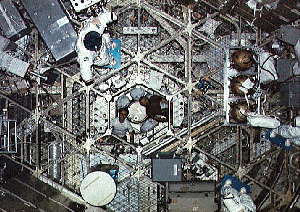|
Industrial Science Laboratory

Function:
To carry out industrial production processes

 You may wonder why a space station would have an Industrial Laboratory on board. The main reason is the space station's microgravity environment. A great deal of research has been, and will be, done on board orbiting spacecraft. Materials Science is a very important tool of industry, involving anything from the production of unusual metal alloys, to thin film polymers. Growing perfect crystals for use in electronic products is possible as is the manufacture of perfect spheres in many materials. In fact, one of the most productive and profitable uses of our Space Station is its Industrial Laboratory. As you can see, we can make materials and products that are impossible on Earth. This is only possible because of the microgravity conditions which you might know better as zero-g or weightlessness. You may wonder why a space station would have an Industrial Laboratory on board. The main reason is the space station's microgravity environment. A great deal of research has been, and will be, done on board orbiting spacecraft. Materials Science is a very important tool of industry, involving anything from the production of unusual metal alloys, to thin film polymers. Growing perfect crystals for use in electronic products is possible as is the manufacture of perfect spheres in many materials. In fact, one of the most productive and profitable uses of our Space Station is its Industrial Laboratory. As you can see, we can make materials and products that are impossible on Earth. This is only possible because of the microgravity conditions which you might know better as zero-g or weightlessness.
Image: Skylab 4 Mission - The interior of the Orbital Workshop © Image: NASA
The other major difference between Earth and Space is vacuum. Outside the spacecraft there is almost no air. It is one of the best vacuums that can be achieved. Many industrial processes work well in a vacuum, the smelting of some metals, for instance.
Gravity on Earth has a very profound effect on the production of materials, it affects the way the atomic structures form (for instance when two metals are heated and combined to form an alloy). Without gravity's effect the minute defects in an alloy, which could cause structural failure, can be prevented. This is not new. More than two hundred years ago it was found that better shot for muskets could be cast by dropping the molten lead from the top of 30 m towers (100 feet), so that the lead cooled as it was in free-fall and produced nearly perfectly round balls.
Any new material produced in space is no longer restricted by the effects of buoyancy, sedimentation and hydrostatic pressure. Also fluid dynamics and transport phenomena can be studied and better understood, without being dominated by the effects of gravity.

Project
Simple demonstrations of micro-gravity are easy to demonstrate. Take a plastics drinks bottle, make some holes in it. Put it in the sink or go outside and fill it with water. What happens?
Yes! It leaks.
Now go somewhere you can SAFELY drop the bottle several metres, and fill it again. Now drop it and see what happens to the leaks.
You are watching the bottle and water under weightless (micro-gravity) conditions as it falls.

Go to Space Station 2020 Specification
Return to title page
 |













